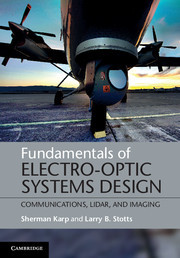Description
Fundamentals of Electro-Optic Systems Design
Communications, Lidar, and Imaging
Authors: Karp Sherman, Stotts Larry B.
Presents practical electro-optical applications in the context of the fundamental principles of communication theory, thermodynamics, information theory and propagation theory.
Language: English
Subject for Fundamentals of Electro-Optic Systems Design:
Approximative price 126.22 €
In Print (Delivery period: 14 days).
Add to cart
Publication date: 12-2012
318 p. · 17.9x25.3 cm · Hardback
318 p. · 17.9x25.3 cm · Hardback
Description
/li>Contents
/li>Biography
/li>
Using fundamentals of communication theory, thermodynamics, information theory and propagation theory, this book explains the universal principles underlying a diverse range of electro-optical systems. From fiber optics and infra-red imaging to free space communications and laser remote sensing, the authors relate key concepts in science and device engineering to practical systems issues. A broad spectrum of coherent and incoherent imaging and communications systems is considered, accompanied by many real-world examples. The authors also present new insights into LIDAR and free space communications and imaging, providing practical guidance on identifying the fundamental limitations of transmission and imaging through deleterious channels. Accompanied by online examples of processed images and videos, this uniquely tailored guide to the fundamental principles underlying modern electro-optical systems is an essential reference for all practising engineers and academic researchers in optical engineering.
1. Genesis of electro-optic systems; 2. Role of electromagnetic theory in electro-optics systems; 3. Photo-detection of electromagnetic radiation; 4. Metrics for evaluating photo-detected radiation; 5. Contrast, visibility and imaging; 6. Signal modulation schemes in optical communications; 7. Forward error correction coding; 8. Modern communications designs for FOC/FSOC applications; 9. Light detection and ranging (LIDAR); 10. Communications in the turbulent channel; 11. Communications in the optical scatter channel.
Sherman Karp received his PhD from the University of Southern California, and has gone on to work with both NASA and DARPA as Principal Scientist. The author of several books, he has also been awarded the SECDEF Medal for Meritorious Civilian Service and NOSC 'Scientist of the Year'. He is a Fellow of the IEEE.
Larry B. Stotts received his PhD from the University of California, San Diego and is a former Deputy Office Director for the Strategic Technology Office, DARPA. He has been awarded two DARPA Technical Achievement Awards, two SECDEF Medals for Meritorious Civilian Service and the NOSC Technical Director's Award. He is a Fellow of the IEEE and SPIE.
Larry B. Stotts received his PhD from the University of California, San Diego and is a former Deputy Office Director for the Strategic Technology Office, DARPA. He has been awarded two DARPA Technical Achievement Awards, two SECDEF Medals for Meritorious Civilian Service and the NOSC Technical Director's Award. He is a Fellow of the IEEE and SPIE.
© 2024 LAVOISIER S.A.S.
These books may interest you

Engineering Optics 116.04 €



